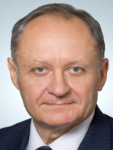Superconducting artificial neural networks and quantum circuits

Prof. Anatolie S. Sidorenko, Technical University of Moldova, Chisinau, Republic of Moldova
The future of high-performance computing with reduced energy consumption is clearly addressed to technologies with lower energy dissipation. А logical solution and the most promising candidate for a radical reduction in energy consumption is the superconducting digital technology (SDT) based on Josephson junctions. The energy consumption of the SDT basic element is in the order of 10−19 Joule, corresponding to up to seven orders of magnitude less energy dissipation than that for their semiconductor analog.
The main goal of this thematic issue is to highlight this new area of research – artificial neural networks – based on SDT and on superconductor/ferromagnetic hybrid nanostructures, and their applications in quantum electronics and spintronics, to highlight the fascinating world of superconducting nanoelectronics.
Research contributions to this thematic issue may include but are not limited to the following topics:
- Artificial neural networks and qubits
- Functional superconductor/ferromagnetic nanostructures
- Proximity effect and Andreev reflection in superconductor/ferromagnetic hybrid structures
- Non-uniform superconductivity, including FFLO state and triplet pairing
- Spin-valve effect and memory cells
- Josephson effect in S/F hybrid structures
Submission deadline: October 31, 2025
Transfer function of an asymmetric superconducting Gauss neuron
- Fedor A. Razorenov,
- Aleksander S. Ionin,
- Nikita S. Shuravin,
- Liubov N. Karelina,
- Mikhail S. Sidel’nikov,
- Sergey V. Egorov and
- Vitaly V. Bol’ginov
Beilstein J. Nanotechnol. 2025, 16, 1160–1170, doi:10.3762/bjnano.16.85

Modeling magnetic properties of cobalt nanofilms used as a component of spin hybrid superconductor–ferromagnetic structures
- Aleksey Fedotov,
- Olesya Severyukhina,
- Anastasia Salomatina and
- Anatolie Sidorenko
Beilstein J. Nanotechnol. 2025, 16, 1557–1566, doi:10.3762/bjnano.16.110

Few-photon microwave fields for superconducting transmon-based qudit control
- Irina A. Solovykh,
- Andrey V. Pashchenko,
- Natalya A. Maleeva,
- Nikolay V. Klenov,
- Olga V. Tikhonova and
- Igor I. Soloviev
Beilstein J. Nanotechnol. 2025, 16, 1580–1591, doi:10.3762/bjnano.16.112

Energy spectrum and quantum phase transition of the coupled single spin and an infinitely coordinated Ising chain
- Seidali Seidov,
- Natalia Pugach and
- Anatolie Sidorenko
Beilstein J. Nanotechnol. 2025, 16, 1668–1676, doi:10.3762/bjnano.16.117

Programmable soliton dynamics in all-Josephson-junction logic cells and networks
- Vsevolod I. Ruzhickiy,
- Anastasia A. Maksimovskaya,
- Sergey V. Bakurskiy,
- Andrey E. Schegolev,
- Maxim V. Tereshonok,
- Mikhail Yu. Kupriyanov,
- Nikolay V. Klenov and
- Igor I. Soloviev
Beilstein J. Nanotechnol. 2025, 16, 1883–1893, doi:10.3762/bjnano.16.131

Quantum circuits with SINIS structures
- Mikhail Tarasov,
- Mikhail Fominskii,
- Aleksandra Gunbina,
- Artem Krasilnikov,
- Maria Mansfeld,
- Dmitrii Kukushkin,
- Andrei Maruhno,
- Valeria Ievleva,
- Mikhail Strelkov,
- Daniil Zhogov,
- Konstantin Arutyunov,
- Vyacheslav Vdovin,
- Vladislav Stolyarov and
- Valerian Edelman
Beilstein J. Nanotechnol. 2025, 16, 1931–1941, doi:10.3762/bjnano.16.134

Hartree–Fock interaction in superconducting condensate fractals
- Edward G. Nikonov,
- Yajiang Chen,
- Mauro M. Doria and
- Arkady A. Shanenko
Beilstein J. Nanotechnol. 2025, 16, 2177–2182, doi:10.3762/bjnano.16.150

Electromagnetic study of a split-ring resonator metamaterial with cold-electron bolometers
- Ekaterina A. Matrozova,
- Alexander V. Chiginev,
- Leonid S. Revin and
- Andrey L. Pankratov
Beilstein J. Nanotechnol. 2025, 16, 2199–2206, doi:10.3762/bjnano.16.152























































